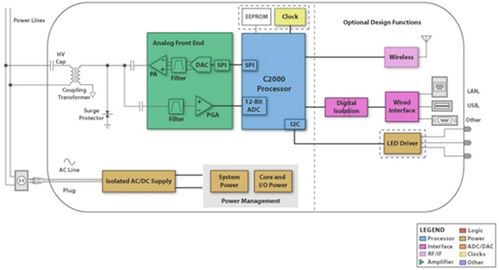Power line communication (PLC) is, at first glance, an attractive and convenient way to bring intelligent monitoring and control to many commercial and industrial applications. Due to the availability and accessibility of the power line, it's an enabling technology for “Smart Grid” uses from smart metering, lighting control, solar power, electric vehicle charging, building automation (HVAC), and security.
When you think about it, trying to use the wide-open power line as a communications medium is not only daunting, but perhaps slightly crazy. On the transmit side, you must inject a high-current signal onto the low-impedance power line with enough amplitude to hopefully be seen at the receiver despite basic attenuation; at the receiver, you try to extract that tiny signal buried by a large AC voltage, and smothered by random noise and spikes of many varieties (forget about Gaussian white noise here). You then need to derive power from the line or a local DC supply. Finally, you must implement wired or wireless interfaces to the outside world for the data I/O. All of these functions must be done via electrically isolated circuits to protect the modem and user.
This means that engineering and validating a power line modem is a difficult design-team challenge. It requires a mix of engineering skills and expertise is disciplines spanning AC-line interface (isolation, signal and safety issues); an analog front end which must deal with severe noise issues; isolation of the power supply and power management; and the signal processing knowledge to encode the data into the proper modulation scheme (FSK and OFDM are common options) and then extract the signal from all that noise and demodulate the data on the receive……

Learn More about the TMDSPLCKIT-V3 C2000 Power Line Modem Developer’s Kit

Buy the TMDSPLCKIT-V3 C2000 Power Line Modem Developer’s Kit now at Mouser Electronics
This Post originally appeared in the On the Grid blog on E2E.
For more On the Grid blog posts, click here.
Advertisement
Learn more about Texas Instruments





